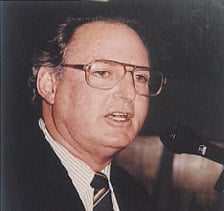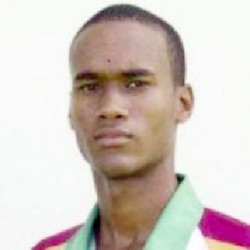By Tony Cozier
SHIVNARINE CHANDERPAUL had to wait into the late afternoon on the opening day of the first Test against Bangladesh in St.Vincent on Friday before he could start his first Test innings as a 40-year-old.
By the time he got in, Kraigg Brathwaite was already past his second Test hundred; 19 years, 144 Tests and 27 hundreds his junior, the opening batsman’s single-minded defiance, driven by unwavering concentration, mark him as an unmistakable Chanderpaul clone.
Like Chanderpaul, there is no beauty about his batting. There are no booming drives, no lofted hits; his most attacking strokes are the cut, interspersed with the occasional off-drive.
The purpose of his batting is steady accumulation of runs, carefully compiled. There were 45 singles and 10 twos against 11 fours in his maiden hundred, 129 against New Zealand in Port-of-Spain in June; the count on Friday was 43-15-8.
Television analysts remark as much about his strong bottom hand as they do about the left-handed Chanderpaul’s quirky front-on stance; along with the opposite way they stand at the crease and their place in the batting order, it is a trait they do not share.
Friday’s was the latest of Brathwaite’s hundreds. He is reliably reported to have close to 50 at all levels – school,

domestic and international under-19s, regional first-class and ‘A’ team internationals and now Tests.
While Chanderpaul’s mindset was fashioned as a boy by countless hours of batting on a three-quarter pitch against his father, uncle and the accommodating folk of Unity Village, just outside the Guyana capital of Georgetown, Brathwaite came through one of the West Indies’ strongest cricket schools, Combermere in Barbados, that had previously nurtured the early development of thirteen West Indies Test players.
Brathwaite was the fourteenth. Chris Jordan, who skippered Combermere before taking up a scholarship at Dulwich College in England, is the fifteenth; the difference is that his team is his adopted England where he made his name in the county game.
(Neither is quite as globally famous or as wealthy as their contemporary, the pop superstar, Rihanna, who was just Robin Fenty at Combermere).
Among the school’s earlier Test men were two West Indies captains, Denis Atkinson and the revered Sir Frank Worrell, the third of the ‘W’ triumvirate, Sir Clyde Walcott (who later transferred to Harrison College) and two outstanding fast bowlers of the 1930s, Herman Griffith and Manny Martindale, and another of the 1960s, Sir Wes Hall.
Aged 17 years, 122 days, Derek Sealy had to be given permission by Combermere’s headmaster to skip classes so he could play the 1930 Test against England at Kensington Oval. It was his first of eleven; he remains the youngest of all West Indies Test players.
Chanderpaul, 19, and Brathwaite, 18, were also teenagers on their Test debuts. Both took time to settle. Chanderpaul first hundred, 137 not out against India in Bridgetown in 1997, came in his nineteenth match; Brathwaite’s breakthrough against New Zealand was his eleventh.


In times when Twenty20 rules, Brathwaite is something of an anachronism. Selectors don’t consider his name when sifting through their short-format options. He is not bothered; Chanderpaul has been similarly pigeon-holed. Brathwaite adheres to his idol’s mantra.
“If you play bad shots, you’re going to get out,” Chanderpaul reasoned in an interview with me a couple of years back. “If you hit the ball in the air, you’re going to get out. If you can bat to 50, you can bat to 100. In Twenty20 cricket, guys just give themselves room and fire. They don’t care if they get out. This is why Test cricket will always be the ultimate; it tests you as to whether you are a man or a boy.”
With 157 Tests, 11,415 runs, 29 hundreds and an average of 51.88, Chanderpaul has long since proved his cricketing manhood. Brathwaite has only just set out on the journey to verify his.
With the exception of two Under-19 World Cup tournaments in New Zealand and Australia, he has accumulated all his runs on the similar pitches of the Caribbean, Bangladesh and India. One newspaper described Bangladesh’s bowling on Friday as “lightweight”; including two young promising spinners on debut, “bantamweight” would have been a more valid description.
Brathwaite faces his first examination by 90 mph/145 kph pace on faster, bouncier pitches than he has so far encountered in three Tests in South Africa in December and January. England, with their high-class swingers, James Anderson and Stuart Broad, follow next April and May. It will all be “learning curve”, to use the popular expression.
There are enough instances through the game’s history to inform him of how quickly fortunes can change in this most fickle of sports. He need go no further than the experiences of Adrian Barath and Kieron Powell, with whom he has shared opening partnerships for West Indies.
Aged 19, Barath was the youngest West Indian to score a hundred on debut, 104 against Australia in Brisbane in 2009. He went into subsequent decline; the last of his 15 Tests was two years ago.
The left-handed Powell joined an elite group of West Indians when he scored hundreds in each innings against Bangladesh in Dhaka in 2012. Like Barath, his form deserted him in series in India and New Zealand late last year; he was dropped after failures in the first Test against New Zealand in Kingston in June.
Brathwaite took his place. Given his impressive background and unencumbered by the demands of the other two formats of the game, it would be a disappointment, indeed a surprise, if he too drifts into early oblivion rather than gradually follow the giant footsteps of Chanderpaul.





